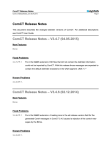Download The User's Guide to Scheduling in CEE Region Trader's
Transcript
The User's Guide to Scheduling in CEE Region Trader's Manual Version 1.3.0.0 Last Update: 03.11.2010 1.1.0.0 released Page 1 / 18 Disclaimer : This entire document is for public consultation and shall be understood as a general scheme which shall provide the basic knowledge about the scheduling processes and scheduling IT system requirements. While it is intended the information to be accurate, no warranties of any kind are made with respect to the information, including without limitation any warranties of accuracy or completeness. Neither CAO Central Allocation Office GmbH nor CEE TSOs (ČEPS a.s., ELES Electro-Slovenija d.o.o., MAVIR Hungarian TSO Company Ltd., PSE Operator S.A., SEPS a.s., transpower stromübertragungs gmbh, 50Hertz Transmission GmbH, Verbund - Austrian Power Grid AG) shall be responsible for any damage or loss of any kind arising out of or related to use of the information provided in this document. Last Update: 03.11.2010 1.1.0.0 released Page 2 / 18 TABLE OF CONTENTS 1 2 3 INTRODUCTION......................................................................................................4 1.1 Purpose of the Document ..................................................................................4 1.2 Scope of this Document ....................................................................................4 1.3 Definitions and abbreviations .............................................................................4 GENERAL DEFINITIONS ...........................................................................................6 2.1 Business processes...........................................................................................6 2.2 Communication to TSOs and CAO .......................................................................6 2.3 Borders between non-neighbouring Control Areas .................................................6 2.4 Cross border Nomination ...................................................................................6 2.5 Example of nomination .....................................................................................7 2.6 TSOs reactions.................................................................................................8 2.7 Description of processes.................................................................................. 10 2.7.1 Long Term nomination .............................................................................. 11 2.7.2 Correction Cycle Long Term ....................................................................... 12 2.7.3 Deadline for Calculation of Curtailment by CAO............................................. 12 2.7.4 Short Term Nomination ............................................................................. 13 2.7.5 Correction Cycle Short Term ...................................................................... 13 APPENDIX............................................................................................................ 14 3.1 Curtailment of nominated transmission rights..................................................... 14 3.2 ETSO ESS 2.3/ESS 3.3.................................................................................... 14 3.2.1 Definitions............................................................................................... 14 3.2.2 Example ................................................................................................. 15 3.3 Referenced documents.................................................................................... 18 Last Update: 03.11.2010 1.1.0.0 released Page 3 / 18 1 INTRODUCTION 1.1 Purpose of the Document The User’s Guide for Scheduling provides description of all scheduling processes and scheduling IT system’s requirements to be implemented by electricity trading companies in CEE Region. The harmonization of the scheduling-processes and therefore all necessary individual changes in the scheduling systems of the TSOs in the CEE-region are preconditions for the introduction of flow based capacity allocation, introducing bidding and nomination also between non-neighbouring transmission system operators. 1.2 Scope of this Document This document was developed by the representatives of the CEE TSOs using state of the art technology and best business practices in the field of cross-border schedule nomination. For the sake of clarification, the document provides general description of the functionalities of all scheduling processes; however its main target is exact definition of necessary changes in the User’s IT systems as well as the description of possible responses/scenarios in case of mismatched nomination for long-term and short-term processes. National requirements or internal matters of a single Trader, rules on borders with other regions, intraday scheduling and cross border balancing are not covered by this document. The complete solution is universal and can be also used in a non-flow based allocation mechanism. 1.3 Definitions and abbreviations Abbreviation Description Remark ACK Acknowledgement document ANO Anomaly report CA Control Area of CEE Region CAI Capacity Agreement Identification CAO Central Allocation Office CCT Capacity Contract Type CNF Confirmation report CNTR Curtailment of Nominated Capacity Rights COT Cut Off Time FBA Flow based allocation process Last Update: 03.11.2010 Gate by this ITRs have the possibility to correct nominations referring to time series submitted by an Anomaly document from TSO, received after relevant GCT 1.1.0.0 released Page 4 / 18 GCT Gate Closure Time ITR Interconnection Responsible SO System Operator SO is used referring to the ECAN document. In the context of this guide TSO is meant. TSO Transmission System Operator TSO of CEE Region Last Update: 03.11.2010 Gate by this the ITRs have to nominate the used capacity to their local TSO Trade Market participant with a balancing contract for one or more control areas. An ITR is a market player who nominates allocated capacity on one side of a border. In the context of this guide the ITR is responsible for the nomination of already allocated rights to the SO in the CA he acts. 1.1.0.0 released Page 5 / 18 2 GENERAL DEFINITIONS 2.1 Business process The business process between ITRs and TSOs will be standardized. This especially regards the timeline and the communication. The scheduling will be done seven days a week without any regards to any holidays within the related areas. 2.2 Communication between ITRs and TSOs/CAO The defined communication standards are • 0 ETSO ESS 2.3 and/or ETSO ESS 3.3 - according to local market rules • 0 ETSO ECAN 4.0 • 0 ETSO ESS Code list 0 • 0 ETSO Acknowledgement Document 5.0 if ETSO ESS 3.3 or ECAN 4.0 is used 2.3 Borders between Control Areas In CEE Region the nomination is currently executed on twelve borders between neighbouring CAs. Table 1: General definition of the border No Source (outArea) Sink (InArea) Border 1 10YCountry1-TSO1------L 10YCountry2-TSO2-----S TSO1 – TSO2 2 10YCountry2-TSO2-----S 10YCountry1-TSO1------L TSO2 – TSO1 With the introduction of FBA the nomination will be extended to non-neighbouring borders of the CEE Region. 2.4 Cross border Nomination Schedules for nominations will be sent to the TSOs in accordance with local market rules in ESS 2.3. or ESS 3.3. General rules for the format of nominations in local market areas will not change but content of used elements and the usage of some elements used for nomination within the CEE Region may differ: • Business Type: Use of “A03” is mandatory • CapacityAgreementIdentification: given by the CAO in the Rights Document • CapacityContractType: in accordance with the Auction Rules, depending on auction type (used CCTs: A04-right from yearly auction, A03-right from monthly auction, A01 right from daily auction) Last Update: 03.11.2010 1.1.0.0 released Page 6 / 18 Cross nominations (N:M) are allowed. That means that InParty and OutParty does not need to be the same. Anyway, 1:1 nomination is still possible. Moreover, the ITR which is owner of capacity rights can use allocated rights with more than one partner on other side of the border. 2.5 Example of nomination TSO1 (EIC_TSO_1) Capacity right TSO2 (EIC_TSO_2) CAI: T1T20001 CCT: A04 (right from the yearly auction) Owner: ITR1 ITR4 (EIC_ITR_4) ITR1 (EIC_ITR_1) ITR2 (EIC_ITR_2) ITR3 (EIC_ITR_3) ITR1 (EIC_ITR_1) Basic Rules: • • • The direction of nominations and the direction of the relevant capacity right must be the same One of the ITRs on either side must be the owner of the capacity right. In case of 1:1 nomination as special case of cross border nomination the ITRs on both sides and the owner are the same The total of the volume in the nominated time series using the same CAI must not exceed the volume of the respective capacity right Headers of nomination schedules of ITR1 to TSO1: <InArea codingScheme="A01" v="EIC_TSO_2"/> <OutArea codingScheme="A01" v="EIC_TSO_1"/> <InParty codingScheme="A01" v="EIC_ITR_2"/> <OutParty codingScheme="A01" v="EIC_ITR_1"/> <CapacityContractType v="A04"/> <CapacityAgreementIdentification v="T1T20001"/> Last Update: 03.11.2010 1.1.0.0 released Page 7 / 18 <InArea codingScheme="A01" v="EIC_TSO_2"/> <OutArea codingScheme="A01" v="EIC_TSO_1"/> <InParty codingScheme="A01" v="EIC_ITR_1"/> <OutParty codingScheme="A01" v="EIC_ITR_1"/> <CapacityContractType v="A04"/> <CapacityAgreementIdentification v="T1T20001"/> <InArea codingScheme="A01" v="EIC_TSO_2"/> <OutArea codingScheme="A01" v="EIC_TSO_1"/> <InParty codingScheme="A01" v="EIC_ITR_4"/> <OutParty codingScheme="A01" v="EIC_ITR_1"/> <CapacityContractType v="A04"/> <CapacityAgreementIdentification v="T1T20001"/> Header of nomination schedule of ITR3 to TSO1: <InArea codingScheme="A01" v="EIC_TSO_2"/> <OutArea codingScheme="A01" v="EIC_TSO_1"/> <InParty codingScheme="A01" v="EIC_ITR_1"/> <OutParty codingScheme="A01" v="EIC_ITR_3"/> <CapacityContractType v="A04"/> <CapacityAgreementIdentification v="T1T20001"/> Nomination schedules to TSO 2 will be generated analogically 2.6 TSOs reactions When a document with a schedule nomination is received by the TSO it will be formally checked immediately. If the result of the formal check is OK the ITR gets an Acknowledgement document with the reason code A01. If a validation against the rights document couldn’t be executed during the formal check because of non-availability of the Capacity Rights Document the ITR can be informed by an additional reason Code A75 within the Acknowledgement document. In case of formal errors the TSO doesn’t accept the document. It will be rejected; reason codes and reason texts are given in the Acknowledgement document. If the Capacity Rights Document is available for the TSO at this time, ITRs will be informed by the TSO of an exceeded capacity rights with an additional Anomaly report. If the Capacity Rights Document is received later on or a nomination from another ITR leads to an exceeding of a capacity rights, the ITR will be informed by an Anomaly report after the detection of exceeding capacity. Besides the exceeding of capacity rights the Anomaly report can contain detected mismatches depending on the process step. An Anomaly Report will always contain the original values of the sender and, if available, the original values of its counterpart. Table of Acknowledgement document /Anomaly Report Reason Codes (TimeSeries Level): Reason code Description of the RC which should be submitted in the Reason Text Document Type ITRs Action A62 Invalid business type ACK (rejection) Correct the BusinessType to “A03” and send again Last Update: 03.11.2010 1.1.0.0 released Page 8 / 18 A75 Validation against capacity rights document not possible ACK (accepted) The validation against capacity rights documents shall be performed later on, after receiving relevant capacity rights document. No action from ITR is expected. A76 Inconsistency between CCT and CAI ACK (rejection) Correct CCT and/or CAI and resend the nomination ANO Correct the nomination in accordance with the RD and local market rules and send it once again. If the time series is a zero time series no ANO will be sent. Not compliant to local market Rules; RC is used if Quarterly-hour values in one hour different In party/Out party invalid; RD us used if neither the InParty nor the OutParty is the rights holder ACK (rejection) Correct the values so that all 4 quarterly-hour values of one hour are identical. ANO Correct InParty or OutParty or delete the time series from the document or set the values of the wrong time series to zero. The precise proceeding depends on local market rules A27 Cross Border Capacity exceeded ANO Correct time series or contact rights owner, error can be a result of other ITRs nomination A28 Counterpart time series missing ANO Contact counterpart in other area and add or correct time series A09 Time series not ANO matching Contact counterpart in other area or correct values in time series A57 Deadline exceeded The document contains changed nominations and/or added nominations for which the deadline was exceeded. Correct to the last confirmed nominated values and send the document again if necessary A59 A22 limit ACK (rejection) Please note that the rules concerning global (scheduling) positions depend on the local market rules. This means that in some market areas in the corrected nomination an ITR must skip the time series with invalid CAI+CCT, while in other areas an ITR must provide the time series with the invalid header information and set the values to zero. Most of these problems can be solved bilaterally between the involved ITRs. Last Update: 03.11.2010 1.1.0.0 released Page 9 / 18 2.7 Description of processes Figure 1 illustrates long- and short-term processes in relation to other non-scheduling processes, e.g. operation of secondary market and auctions. The general descriptions of functionalities of individual processes are provided within following chapters. Figure 1: Process diagram, • CNTR takes place only in case of FBA Step Process From/By ITR´s actions TSO’s action 1 Long Term nomination by D-2 17:00 Send nominations Send ACK and if necessary ANOs to the ITR 2 Correction cycle Long Term D-2 17:00 18:00 Correct invalid nominations, which are part of an Anomaly report received from TSO during correction cycle. It’s not permitted to change values of already confirmed nominations Send CNF, containing all confirmed nominations; Last Update: 03.11.2010 1.1.0.0 released Send ANO to ITRs, containing nominations with mismatches and with referring to exceeded capacity rights which should be corrected and renominated by ITR Page 10 / 18 3 COT is reached D-2 18:00 Send CNF, containing all confirmed nominations. Nominations with errors at the COT will be modified in accordance with the agreed rules 4 Deadline for curtailment calculation at CAO (CNTR) With the introduction of FBA the process will be extended to the CNTR Send CNF, containing all confirmed nominations. Nominations can be curtailed if necessary. 5 Start of Daily auction D-1 09:00 6 Short term nomination D-1 10:00 – 14:30 (PSEO borders till 13:30) Send nomination schedules Send ACK and if necessary Anomaly report to the ITR 7 Correction cycle short term D-1 14:30 – 15:30 (PSEO borders 13:30 – 14:15) Correct invalid nominations, nominations must be part of an Anomaly report generated during correction cycle. It’s not permitted to change values of already confirmed nominations Send CNF, containing all confirmed nominations; 8 COT is reached D-1 15:30 (PSEO borders 14:15) Send ANO, containing nominations with mismatches and with referring to exceeded capacity rights which should be corrected and renominated by ITR Send CNF, containing all confirmed nominations. Nominations with errors at the COT will be modified in accordance with the agreed rules Described gate closures and cut off times are set as parameters and can be changed in future. The intraday nominations will be performed according to local market rules and are outside of the scope of this document. 2.7.1 Long Term nomination Last Update: 03.11.2010 1.1.0.0 released Page 11 / 18 During this period the ITR may send nominations. According to local market rules at this stage of the process the TSO may send • • • Information that the schedule was received Positive or negative Acknowledgement Document Anomaly report In case of errors the ITR should correct the nominations as soon as possible. 2.7.2 Correction Cycle Long Term During correction cycle a new matching process between the TSOs will be started every 15 minutes until COT. After a matching process is finished ITRs get information about confirmed time series (nominations) within a CNF-report. Time series which cannot be confirmed by several reasons are submitted within an ANO-report. A CNF confirming all ITRs’ nominations is sent only once. Sending will not be repeated after further matching processes during correction cycle. Depending on local market rules the result of the matching process is an intermediate or a final Confirmation report sent to the ITR. After an ANO report is received ITR should renominate its portfolio before COT is reached correcting the still unmatched time series which were submitted in the ANO-report. Already matched time series must not be changed anymore. Corresponding time series with zero values and single zero-time series as well (the corresponding TS in this case is missing) get the status of matched time series after the first matching process is finished. They are part of the CNF-report and therefore also cannot be changed anymore in the correction cycle. The correction cycle ends with the long term cut off time (COT). If nominations do not match at COT they are modified in accordance with the following principles and in the following order: 1. In case of mismatch the values are modified to the lower of both values 2. If there are no more mismatches and a capacity right is still exceeded the relevant nominations are curtailed pro rata. The calculated value with decimals is rounded down to the next lower integer value. 2.7.3 Deadline for Calculation of Curtailment by CAO With the introduction of FBA the process will be extended to the CNTR. After the end of long term nomination and as result of CAO’s calculation (CNTR) in rarely cases of emergency it is necessary that TSOs have to curtail the nominations on one ore some borders. After the deadline for this process the ITRs will be informed by a new CNF about the new values. This CNF will contain reason code A70 in the header and for all affected time series on time series level. These are the final values for Long Term nomination. The final values of a long term nomination cannot be changed anymore. Last Update: 03.11.2010 1.1.0.0 released Page 12 / 18 2.7.4 Short Term Nomination After the publishing of daily auction results ITRs have to nominate the rights they want to use. Depending on local market rules the short term nomination to the local TSO has to contain schedules of final long term nominations as well. According to local market rules and at this stage of the process the TSO may send • • • Information that the schedule was received Positive or negative Acknowledgement document Anomaly report In case of errors the ITR should correct the nominations as soon as possible. 2.7.5 Correction Cycle Short Term During the correction cycle the ITRs may send corrected nominations. Same rules and actions are applied as for the long term correction cycle If some nominations do not match at COT they are modified in accordance with the same principles as for long term process. Last Update: 03.11.2010 1.1.0.0 released Page 13 / 18 3 APPENDIX 3.1 Curtailment of nominated transmission rights Curtailment is processed according to following rules: • Curtailed nominated transmission right = (nominated transmission right * Total curtailed nominated transmission right) / Total of nominated transmission right per CAI • Decimals of the result will be rounded down. Allocated Transmission right Total of nominated transmission right (per CAI) Total curtailed nominated transmission right Curtailed nominated transmission right 20 6 + 6 + 8 = 20 15 (15/20)*(6+6+8)=4+4+6=14 20 4 + 6 +8 = 18 15 (15/18)*(4+6+8)=3+5+6=14 3.2 ETSO ESS 2.3/ESS 3.3 3.2.1 Definitions DtdVersion=2 DtdRelease=3 or DtdVersion=3 DtdRelease=3 According to local market rules Header Level • MessageIdentification: provided by sender, unique per day • MessageVersion: new content means new version • MessageType: A01 • ProcessType: A01 • ScheduleClassificationType: A01 • Sender Identification: EIC Party Code of ITR • Sender Role: A01 (ITR) • Receiver Identification: EIC Party code of TSO Last Update: 03.11.2010 1.1.0.0 released Page 14 / 18 • Receiver Role: A04 (TSO) • MessageDateTime: Current time in UTC • ScheduleTimeInterval: Calendar day in UTC Timeseries Level • SendersTimeSeriesIdentification: provided by sender, constant per document and header of timeseries, unique in the document, and all following versions with the same document id and the same day. • SendersTimeSeriesVersion: versioning according to local market rules • BusinessType: A03 • Product: 8716867000016 • ObjectAggregation: A01 or A03 or A04 (depending on local market rules) • In Area: The control area where the energy is to be put (= sink area) • Out Area: The control area where the energy is coming from (= source area) • InParty: ITR responsible for the nomination for the InArea • OutParty: ITR responsible for the nomination for the OutArea • CapacityContractType: A04 = Yearly, A03 = Monthly, A01= Daily, additional codes (A05, A06 according to local market rules) • CapacityAgreementIdentification: <retrieved from CAO> • MeasurementUnit: MAW Period + Interval Level • TimeInterval: equal to ScheduleTimeInterval • Resolution: According to market rules in area • Pos: According to market rules in area • Qty: value in MW, 3 decimals can be used depending on local market rules, all decimals have to be in accordance with the current auction rules 3.2.2 Example The necessary attributes can be differ according to local market rules X and y for DtdRelease and DtdVersion according to local market rules <?xml version="1.0" encoding="UTF-8"?> <?xml-stylesheet type="text/xsl" href="schedule-document.xsl"?> <ScheduleMessage DtdRelease="x" DtdVersion="y"> <MessageIdentification v="C_20071119"/> <MessageVersion v="1"/> <MessageType v="A01"/> <ProcessType v="A01"/> <ScheduleClassificationType v="A01"/> Last Update: 03.11.2010 1.1.0.0 released Page 15 / 18 <SenderIdentification codingScheme="A01" v="<EIC of ITR>"/> <SenderRole v="A01"/> <ReceiverIdentification codingScheme="A01" v="10XCZ-CEPS-GRIDE"/> <ReceiverRole v="A04"/> <MessageDateTime v="2007-11-19T10:22:25Z"/> <ScheduleTimeInterval v="2007-11-18T23:00Z/2007-11-19T23:00Z"/> <ScheduleTimeSeries> <SendersTimeSeriesIdentification v="SCHEDULE_35240"/> <SendersTimeSeriesVersion v="1"/> <BusinessType v="A03"/> <Product v="8716867000016"/> <ObjectAggregation v="A01"/> <InArea codingScheme="A01" v="10YCZ-CEPS-----N"/> <OutArea codingScheme="A01" v="10YAT-APG------L"/> <InParty codingScheme="A01" v="11XCEZ-CZ------1"/> <OutParty codingScheme="A01" v="11XEDFTRADING--G"/> <CapacityContractType v="A04"/> <CapacityAgreementIdentification v="ATCZ001122"/> <MeasurementUnit v="MAW"/> <Period> <TimeInterval v="2007-11-18T23:00Z/2007-11-19T23:00Z"/> <Resolution v="PT15M"/> <Interval> <Pos v="1"/> <Qty v="0.000"/> </Interval> <Interval> <Pos v="2"/> <Qty v="0.000"/> </Interval> <Interval> <Pos v="3"/> <Qty v="0.000"/> </Interval> <Interval> <Pos v="4"/> <Qty v="0.000"/> </Interval> <Interval> <Pos v="5"/> <Qty v="0.000"/> </Interval> ... ... <Interval> <Pos v="93"/> <Qty v="0.000"/> </Interval> <Interval> <Pos v="94"/> <Qty v="0.000"/> </Interval> <Interval> <Pos v="95"/> <Qty v="0.000"/> </Interval> <Interval> Last Update: 03.11.2010 1.1.0.0 released Page 16 / 18 <Pos v="96"/> <Qty v="0.000"/> </Interval> </Period> </ScheduleTimeSeries> <ScheduleTimeSeries> <SendersTimeSeriesIdentification v="SCHEDULE_35240"/> <SendersTimeSeriesVersion v="1"/> <BusinessType v="A03"/> <Product v="8716867000016"/> <ObjectAggregation v="A01"/> <InArea codingScheme="A01" v="10YAT-APG------L"/> <OutArea codingScheme="A01" v="10YCZ-CEPS-----N"/> <InParty codingScheme="A01" v="11XEDFTRADING--G"/> <OutParty codingScheme="A01" v="11XCEZ-CZ------1"/> <CapacityContractType v="A04"/> <CapacityAgreementIdentification v="ATCZ001123"/> <MeasurementUnit v="MAW"/> <Period> <TimeInterval v="2007-11-18T23:00Z/2007-11-19T23:00Z"/> <Resolution v="PT15M"/> <Interval> <Pos v="1"/> <Qty v="0.000"/> </Interval> <Interval> <Pos v="2"/> <Qty v="0.000"/> </Interval> <Interval> <Pos v="3"/> <Qty v="0.000"/> </Interval> <Interval> <Pos v="4"/> <Qty v="0.000"/> </Interval> <Interval> <Pos v="5"/> <Qty v="0.000"/> </Interval> ... ... <Interval> <Pos v="93"/> <Qty v="0.000"/> </Interval> <Interval> <Pos v="94"/> <Qty v="0.000"/> </Interval> <Interval> <Pos v="95"/> <Qty v="0.000"/> </Interval> <Interval> <Pos v="96"/> Last Update: 03.11.2010 1.1.0.0 released Page 17 / 18 <Qty v="0.000"/> </Interval> </Period> </ScheduleTimeSeries> </ScheduleMessage> 3.3 Referenced documents ETSO ESS 2.3 ETSO Scheduling System (ESS) Implementation Guide 2.3 ETSO ECAN 4.0 ETSO Capacity Allocation and Nomination System (ECAN) Implementation Guide 4.0 ETSO ESS Code list 10.0 ETSO General Code List For Data Interchange 6.4 ETSO Acknowledgement Document 5.0 ETSO Acknowledgement Document (EAD) Implementation Guide ETSO ESS 3.3 ETSO Scheduling System (ESS) Implementation Guide 3.3 Last Update: 03.11.2010 1.1.0.0 released Page 18 / 18



























